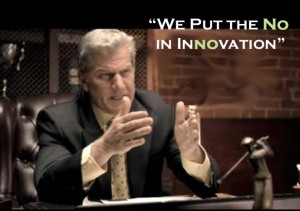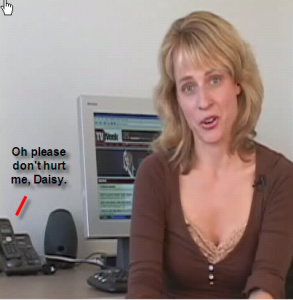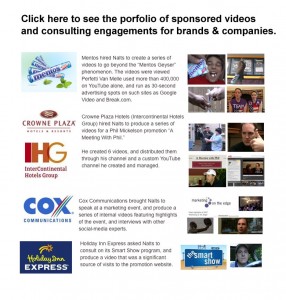
Hi. I’m YouTube. I’ve never spoken before, so forgive me if I sound like a computer. I having been designed by engineers not ‘creative people’ with sub-par GPAs. I wasn’t made by the sales and marketing people who, in college, cheated off those who programmed me. Sorry- that came out wrong. That takes me to my New Year’s Resolutions, and I’m a little buzzed right now. So I’m going to write this down and so I remembering it tomorrow.
I feel like I’ve done a pretty good job in 2010, but I’m not perfect. No machine, much less you humans, is. I’ve got some things to improve in 2011. So now let me getting started.

- I’m going to stop being a dick to agencies. I didn’t realize that online video, unlike paid search, isn’t exactly a self-serve checkout lane at the grocery store. You’re going to totally think this is funny, but I thought you agency people were just idiots spending my customer’s money. Seriously. I realize now you idiots actually add some value. Or at least you’re influencing where brands spend money online, despite your small brains and Madison Avenue bullshit. I know Yahoo and AOL’s media sales representatives are totally more hot than my human selling people, but I hope you’ll give us a second chance. We got off on the wrong foot. Let’s be friends and drink martinis or sangrias or whatever you do to mask the putrid scent of failed dreams or quell your pent-up artistic aspirations. Cheers!
-

Baby New Year looks like a love child from Swiss Miss and Chucky. Who's with me? I’m going to stop acting like a stoned teenager
. Don’t get me wrong, I like those teenagers. I’m not a perv or anything… it’s just that they binge on my video like Alcoholic’s Anonymous noobs suck down cigarettes! I know I made an indelible first impression with most of you. Probably when you hear my name (hey, YouTube!) you generally think of either some ripped SNL skit, or Pandas crapping on skateboard toilets. In my defense, when Google bought me, I tried to just give people the crap they wanted. And oh you humans like your crap. This shizzle worked for search. But then, like “black hat” search-engine optimization trolls, some real crappy video got top billing. And it kinda got stuck in what my Master calls an “infinite loop.” It got stuck in an infinite loop. An infinite loop. Anyway, I didn’t really adjust well for broader audiences. I now realize there are people who will watch online video that agree this dude is a douche, and frankly I can’t sell even diet ads around his vids anyway. S0 I’m working on that. But, dude, I’m not going to become some girly Vimeo artistic local theater or anything. I’m also going to leave the booby videos to the peeps in Tel Aviv. Seriously if you know of any real online-video sites that are doing it right, please let me know. I’ll copy them, acquire them, or destroy them… whatever it takes to be a man. -

I don't know what love feels like, but check out this Asian robot. Is she hawt? I’m going to be more humane.
My programmers are teaching me to be like humans. While they haven’t compiled the code for what you evolved apes call “love” and “empathy,” Master has taught me ways to simulate the job of a broadcast programmer without the Marhals suits and Scotch. In 2009 and even some of 2010, a few dozen “wanna-be stars” totally troll-hacked me into thinking their videos were good. I’m onto them. I am beginning to develop predictable logic about this thing you call “non-suck-ass” video. I’m going to start pimping videos that are “good like.” On my road to being and overtaking humans, please forgive me for occasionally making some stupid video popular or burying something half decent. - I realize I need to be more than a search-engine. Over the past few years I was trying to kiss Google’s ass (it’s my Master). So I was all OCD about video search, while also trying to “thin the Hurl herd” of original YouTube doob heads. Now I realize that this online-video space is uncomfortably different from paid search. People may stick around and watch crap, and I can make a few bucks jamming pre-rolls down their throats and charge really low CPMs and make money. I owe it to you to be more than a map. I need to be the the navigation system, destination and “thing that wouldn’t leave.” If you have unbastardized free time I’ve failed you. I know half of my views are for music videos, but I want to be more than a free jute box to you.
- I’m going to stop jamming bottom-feeder pre-rolls at people. During that last point I realized I probably shouldn’t serve crappy CPM pre-rolls, but go for fewer and more relevant ads. Then I can charge a lot more. My Master told me that one day I too may create a bidding war over my advertising space, so it commands its actual worth. Then, with patience, I can start bidding careless media buyers against each other, and charge a super premium. Oh shit, I forgot about my first resolution. Forget that last point. Anyway my Master doesn’t pay a lot of attention to me because I’m kinda like the Coke machine at the casino, but one day I’m going to be His favorite. You’ll see.
-

I made him. I can destroy him. I’m going to democratize content
. I’ve totally played favorites lately with a few asswipe amateurs. I’ve made a few people temporary millionaires who will be bussing tables and driving Geek Squad vans again soon. A dozen or so people make $100K plus a year. This year I’m going to try to spread the wealth better, and see if I can cultivate better relationships with people who don’t just rally fan bases but actually have something watchable. I’m not talking about those shitty subtitled foreign films or anything, but I’m going to let a few brains on stage. I’ll start with Alf reruns. - I’m going to stop being a dick to networks and producers. I realize I’ve not helped you promote and sell your own ads, and I’m totally going to change all of that this totally completely this year pinky promise. It’s a top priority even though it was like the 7th thing that came to mind. But let’s face it. Who needs whom more? Or as you advertising people say, “who needs who more?”
- I’m going to exercise and start eating well. I’m totally kidding about that. Just busting your balls. I’m going to get fatter and lazier because I’m practically a monopoly. I can apologize for being me, but I’m not going to mean it.
-

All distribution channels will be almost as equal as my Master I’m really going to work on distribution BFFs.
You’ve got to admit I’m a happening Hip Hop bar. But like Starbucks jamming Via into grocery stores, you’ll find me wherever you go. Let’s face it, most people have been coming to me to watch videos, but I’m really, really, really trying to be a platform not some lame-ass portal like AOL or Yahoo or Bling or whatever. I know I’ve been saying that, like, every year. But this year’s going to be different. But can you blame me for not getting my nips all hard over the 127 people using TiVos and AppleTVs? And I don’t even hear iTunes and iPads claiming “do no evil,” much living up to it. Anyway, this year I totally promise — if you’ve got, like, more than maybe a thousand people viewing videos on your stupid little phone, web-video box or elevator kiosk… I’ll pay attention to you. You can have the goods, and I don’t just mean the old “suck on my API or embed.” But let’s make a deal here. Don’t pull any flash cock-blockers or start shouting monopoly crap (because we’ll kick you in your net neutralities). If you’re really nice I’ll even allow you dumbass telephone companies to shit out some pre-rolls via me, and I’ll share a tiny bit of money with you. I mean nobody’s going to buy them, but I’ll try. My Master’s Droid is first in line of course. But our dance floor is huge, so the VIP entrance is the front door. Let’s party! Who else thinks Mark Cuban is a douche bag? YEAH! - Lastly, the viewer comes first. I’m totally going to do right by the viewer and that’s why I saved it for my big finish. Master has taught me my priorities. After bold land-grabbing innovation, vigilant legal, and revenue building, the customer always comes first.








